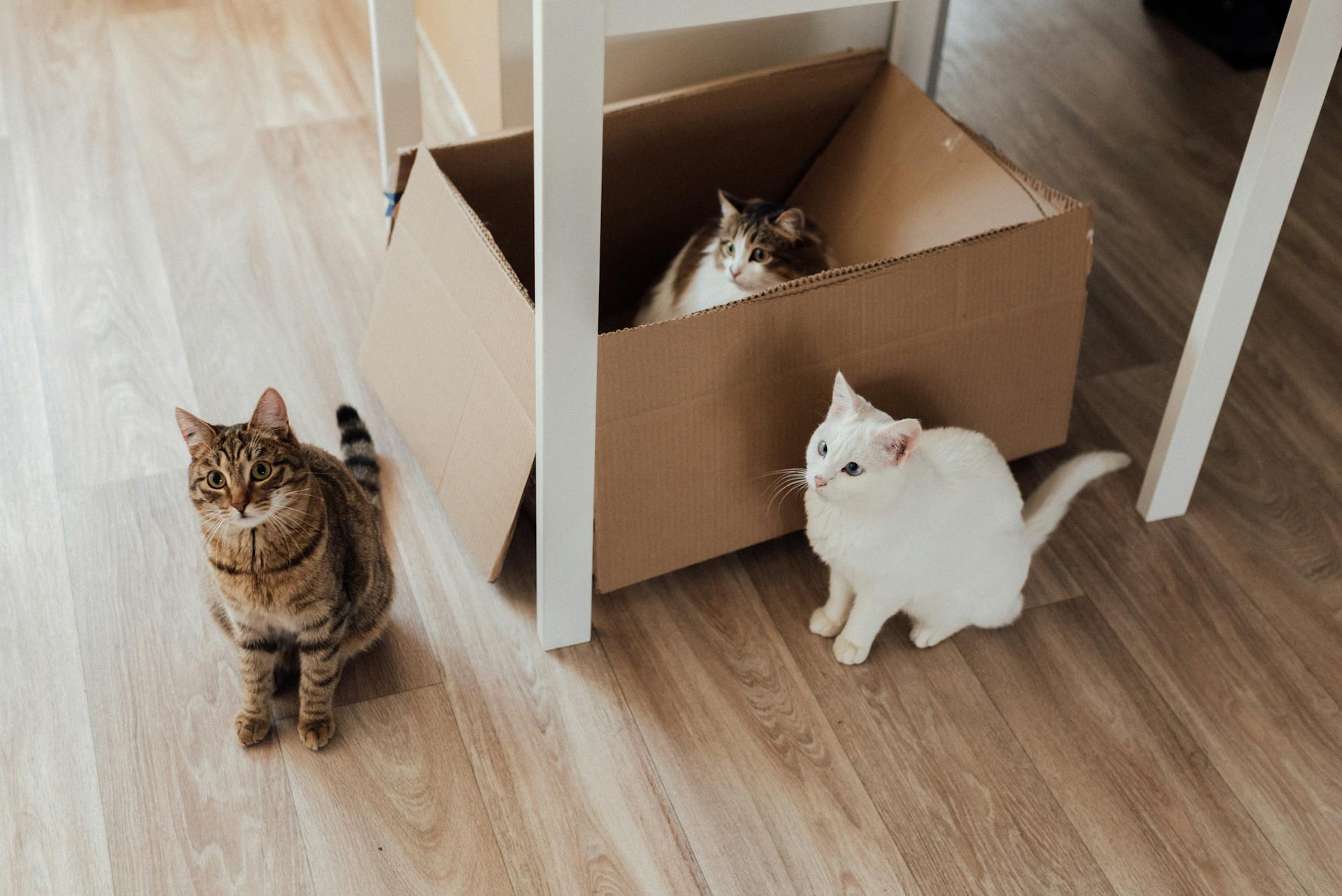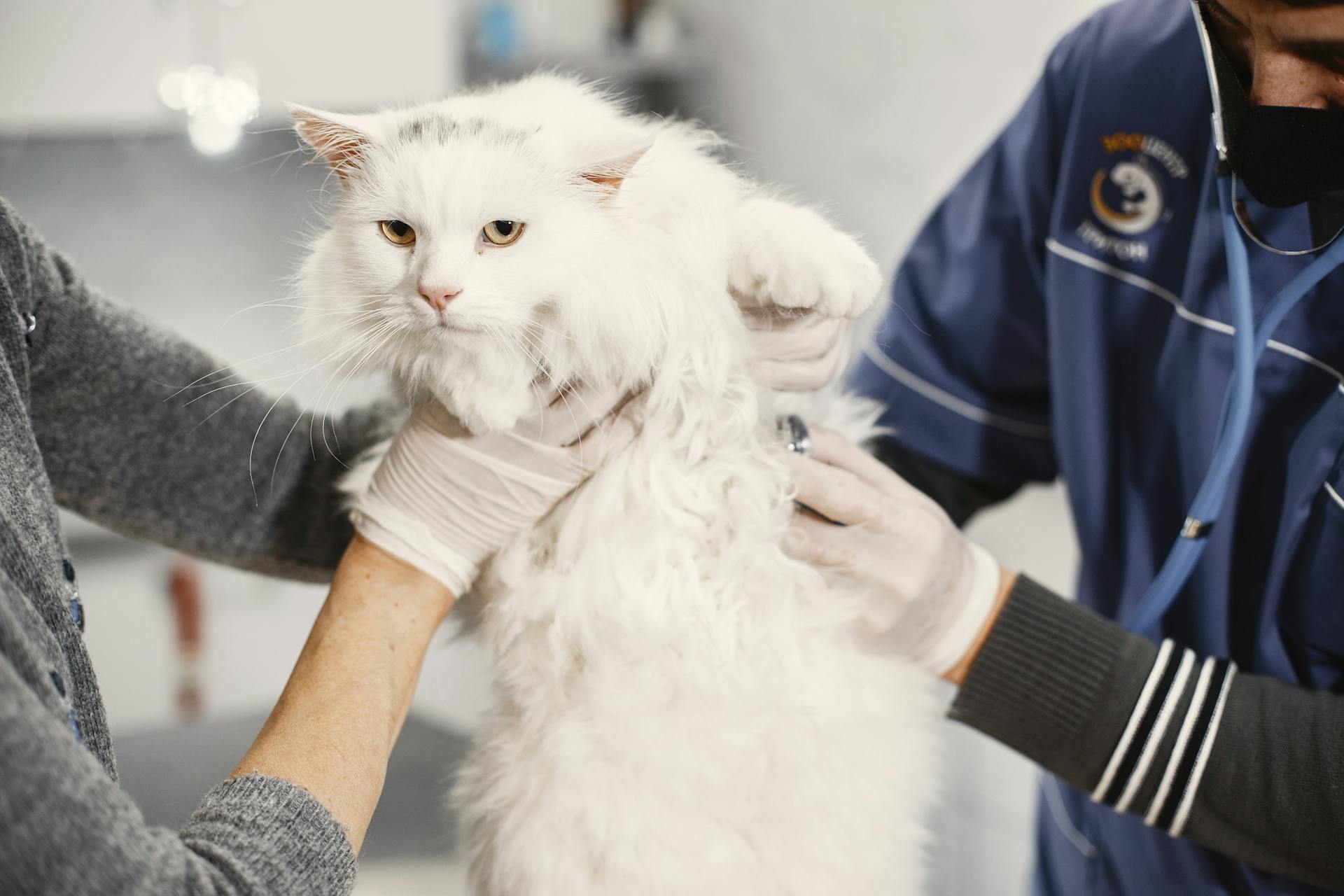
If your cat is wearing an E-collar, also known as a cone of shame, it's likely due to a recent surgery to prevent them from licking or biting the affected area.
E-collars are designed to be worn for a specific period, usually 7-14 days, depending on the type of surgery and your veterinarian's instructions.
Wearing an E-collar can be frustrating for cats, but it's a crucial step in their recovery process.
Take a look at this: E Collar after Surgery
Introduction
Introducing your cat to the e-collar, also known as an e-collar or cone of shame, is a crucial step in their recovery process.
The key is to go slow and make it a positive experience for your cat. If you're introducing the e-collar before they need to wear it, do this gradually over multiple sessions and days.
You'll know your cat is not ready if you see them pulling their head back, turning their ears to the side or back, fidgeting, or twitching their skin.
These signs indicate that your cat needs more time and space to feel comfortable. If you see any of these signs, take a step back and move forward more slowly.
A good rule of thumb is to watch for even small signs of discomfort and adjust your approach accordingly.
Understanding the E-Collar
If you're new to using an Elizabethan collar, or e-collar, on your cat, it's essential to understand how it works. An e-collar is a cone-shaped device that prevents your cat from licking or biting at its wounds.
To put the e-collar on your cat, you'll need to pick it up carefully, depending on its level of cooperation. If your cat is content being handled, you can grab it underneath the abdomen with one hand and hold its chin in place with the other.
The e-collar is typically secured with a loop that you need to close snugly around the cat's neck, without impeding its breathing. It's a good idea to have someone assist you when putting the e-collar on, especially if your cat is not cooperative.
Here are the essential steps to follow when putting the e-collar on your cat:
- Pick up your cat carefully, depending on its level of cooperation.
- Hold the cat securely, either by yourself or with assistance from someone else.
- Slide the e-collar over the cat's face and onto the neck, gently pulling its ears forward.
- Close the loop that secures the e-collar in place, ensuring it fits snugly without impeding the cat's breathing.
Preparing Your Cat
To put the Elizabethan collar on your cat, you'll need to pick it up carefully, as the method varies depending on how cooperative it is.
If your cat is content being handled, grab it underneath the abdomen with one hand and hold it close to your body.
To hold the cat securely, have someone use both hands to hold its front legs while leaning over the table and pressing their arms against the side of the cat.
If your cat is not cooperating, consider asking a second person to hold it in place while you slide the Elizabethan collar on.
You'll want to slide the smaller opening of the e-collar over the cat's face and onto the neck, gently pulling its ears forward.
To close the collar, loop it through the inside of the Elizabethan collar and make sure it fits snugly without impeding your cat's breathing.
If you're in a rushed situation and need to get your cat used to the cone, reward them with positive reinforcement as they move around within their limits.
To help your cat adjust to wearing the cone, consider having someone hold its front legs while you slide the cone on, and make sure to close the collar securely to prevent it from coming off.
Practical Considerations
When introducing a cat to an e-collar, it's essential to do it gradually to prevent stress and anxiety.
The e-collar should be fitted with a pleasant scent, such as a pheromone spray, to make the cat associate it with positive experiences.
The initial fitting should be done in a quiet room with minimal distractions, allowing the cat to get used to the device without feeling overwhelmed.
The e-collar should be adjusted to a comfortable fit, ensuring it's not too tight or too loose, which can cause discomfort or escape.
Living with the Collar
Living with the Collar can be challenging, but it's essential for your cat's health and recovery. Professional help is recommended to ensure the best fit for the Elizabethan collar.
Get a veterinarian to install and remove the collar whenever possible, as they can provide guidance on proper use. A veterinarian will be able to make sure that you have the best fit.
Suggestion: Best Dog Training Instagram Accounts
Refrain from taking the collar off, even if your cat seems uncomfortable. There is no good reason to take it off, and if you do, your cat might ruin the stitching on its wounds.
Ask your veterinarian about alternatives to the Elizabethan collar, such as those that don't block peripheral vision. Consult with your veterinarian about how effective these alternatives are before trying them.
Here are some key things to keep in mind when living with the collar:
- Get a veterinarian to install and remove the collar whenever possible.
- Refrain from taking the collar off, even if your cat seems uncomfortable.
- Ask your veterinarian about alternatives to the Elizabethan collar.
Attach Collar to Cat Cone
Attaching the collar to the cat cone is a crucial step in securing your cat's Elizabethan collar in place. You'll need some ribbon to tie the collar to the cone.
The amount of ribbon you'll need depends on the size of your cat's neck, so be sure to use enough to comfortably fit around their neck.
To attach the collar, simply weave the ribbon through the holes in the collar and your cat's neck. Tie the ends of the ribbon together to hold the collar in place.
Curious to learn more? Check out: Dog Place Mat Training
Litter Box with Cone
If you have a cat that's wearing a cone, consider removing the lid of any covered litter boxes to make it easier for them to enter and exit.
A large, open litter box is ideal for cats in cones, as it reduces the risk of them getting stuck or injured.
You should block off your cat's outdoor access during recovery to ensure proper healing and safety.
Curious to learn more? Check out: Changing Cat Litter Brand Make Cat Sick
What You'll Need:
To help your cat feel comfortable with their cone, you'll need a few specific items. Here are the essentials:
You'll need cat treats or wet food, as these are high-value rewards that can help create a positive association with the cone. Churu treats are a popular favorite among many cats.
A collection of cat toys will come in handy for distracting and entertaining your cat during the acclimation process.
Finally, you'll need the cone itself, which may require some calming pheromones to be applied 30-60 minutes before your cat sniffs it.
Check this out: Peanut Butter Dog Training Treats
Frequently Asked Questions
How long can a cat wear an E-collar?
An E-collar should be worn by a cat for 7-10 days after surgery. If licking persists, contact the postoperative care line for further guidance.
Is an E-collar necessary after spaying cat?
Yes, an e-collar is highly recommended after spaying a cat to prevent licking or chewing at the surgery site, which can lead to complications. It's usually required for 7-10 days, 24 hours a day.
Sources
- https://www.wikihow.com/Put-an-Elizabethan-Collar-on-a-Cat
- https://pennykim.medium.com/diy-e-collar-for-spayed-cats-53d225c3d3
- https://baltousa.com/products/balto-neck-eco-e-collar-alternative-feline
- https://www.cuteness.com/article/make-soft-elizabethan-collar-cats
- https://www.preventivevet.com/cats/your-cat-in-a-cone-collar-desensitization
Featured Images: pexels.com


